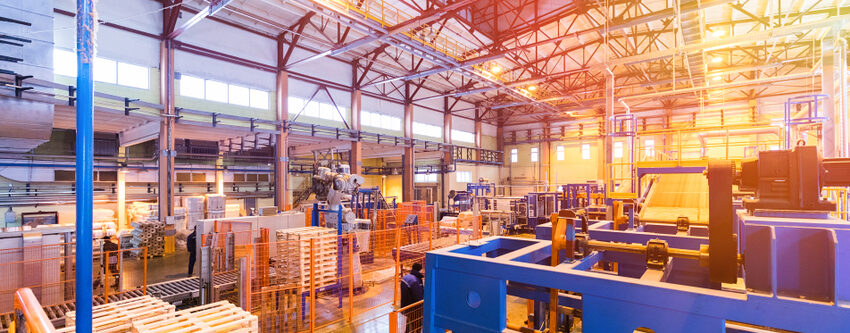Workplace Safety Guide: Manufacturing

Manufacturing is a key spoke in the wheels that drive the Texas economy. In 2020, Texas manufacturers exported $203 billion in goods, making it the number-one exporting state in the nation—a title it has held for nearly 20 years. Much of the credit goes to the more than 880,000 men and women the industry employs.
To secure manufacturing’s prominent position in the Texas economic landscape, we must protect our workers from the hazards they face on the job. If your organization has any manufacturing component, we recommend sharing details on the following hazards with your safety director and anyone involved in the manufacturing process.
Hazard: Strains
Those seemingly minor aches and pains that won’t go away could be symptoms of serious musculoskeletal disorders (MSDs). MSDs include injuries to the joints, muscles, tendons, ligaments, discs and nerves. Unsafe lifting techniques and the strain associated with standing for long periods and using repetitive motions to complete tasks are common causes of MSDs
Controls:
- Use safe lifting techniques such as lifting with your legs instead of your back, keeping the load in your power zone and pivoting with your feet instead of twisting with your body when you need to turn.
- If a load is too heavy, break it into smaller loads, ask a coworker to help or use dollies, carts and other lift aids.
- Alleviate the stress of repetitive motions and awkward postures by using a mix of engineering and administrative controls. Engineering controls include adjustable workstations, diverging conveyors off a main line and tools that allow workers to use neutral postures. Administrative controls include taking breaks, rotating tasks among workers and adjusting production rates.
Hazard: Burns
According to the National Fire Protection Association, 9 out of 10 burns are caused by something other than an open flame. In the manufacturing industry, employees are at risk of burns when they handle hazardous chemicals, conduct welding operations and come into contact with hot objects, liquids, steam and vapors.
Controls:
- Set up restricted areas to keep employees away from hot areas on production equipment whenever possible.
- Use tongs to handle hot objects.
- Wear insulated gloves, clothing and other personal protective equipment.
- Comply with your employer’s hazard communication program when handling chemicals.
Hazard: Struck-by, caught-in-between injuries
Manufacturing shops are busy places. Suspended loads, elevated work areas, machines with moving parts, and forklifts, and other powered industrial vehicles increase workers’ risk of struck-by/caught-in-between accidents.
Controls:
- Follow lockout/tagout and machine guarding procedures to protect yourself from gears, belts, blades and other moving machine parts.
- Avoid loose-fitting clothes, jewelry, and other accessories that can get caught in moving parts. Similarly, secure long hair and beards.
- Inspect forklifts before each shift, making sure horns, backup alarms, and other safety features work properly.
- Do not operate a forklift unless you have been trained and certified. It is a violation of federal law for anyone under 18 to operate a forklift and for anyone over 18 years of age who is not properly trained and certified to do so.
Hazard: Noise
Hearing loss is the most common work-related injury in the US. Workers in the manufacturing industry are at risk because they spend long days sharing workspace with loud machines. The bad news is that once you’ve lost your hearing, you can’t get it back. The good news is that hearing loss is 100 percent preventable.
Controls:
- Implement a hearing conservation program when required by OSHA.
- Eliminate noise at its source by buying quieter equipment, maintaining and lubricating machinery and equipment, using sound walls or curtains, and enclosing or isolating the noise source.
- Reduce exposure to noise by operating noisy machines during shifts when fewer people are exposed and limiting the amount of time a person spends at a noise source.
- Use ear plugs and other personal protective equipment when required.
Hazard: Cuts, punctures, scrapes
Of all the tools you use at work, your hands are the most important. Handling scrap materials, using damaged tools and failing to wear gloves are just a few of the factors that put you at risk of cuts, punctures and scrapes.
Controls:
- Keep tools and equipment in good working condition.
- Choose the right tool for the job.
- Use tools the way they were designed to be use. For example, don’t use a screwdriver as a hammer.
- Inspect tools and power cords before using them. Power cords should have all prongs, and they should not be frayed or missing insulation. Tools should have all safety guards, and there should be no cracks in the casing, loose screws or other damage. If you find damaged equipment, immediately tag it and remove it from service.
- Wear cut-resistant gloves.
Sponsored by:

Caring for Texas for more than 25 years
As the leader of the workers’ compensation market, Texas Mutual is committed to building a stronger, safer Texas. We offer workers’ compensation insurance that protects employers, their businesses, and their employees from the consequences of an on-the job injury or illness. Don’t “go bare”—protect your employees and business with the company who does workers’ compensation bigger and better than anyone else. Whether you work in oil and gas, restaurants, construction, healthcare, auto repair, or any other industry, we’re here to help.


What CEOs Need to Know About Building...
April 28, 2021